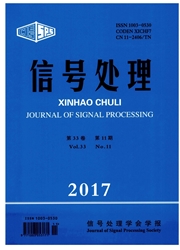

 中文摘要:
中文摘要:
在基本通用分配算法(GAP)的基础上,提出异构无线网络下的均衡GAP算法和纵向效用GAP算法,目的是将,v个业务均衡地分配到M个无线接入网(radio access network,RAN)中.均衡GAP算法分配业务时,选择剩余容量最大的那个RAN接入;而纵向效用GAP算法分配业务时,首先根据各个RAN可提供的数据传输速率,计算每个业务在不同RAN下的纵向效用值,然后选择纵向效用值最大的那个RAN接入业务.仿真结果表明,两种GAP算法都能够使得系统中的负载均衡分配,同时能够有效降低系统的呼叫阻塞率、提高系统平均吞吐量.与基本GAP算法和均衡GAP算法相比,纵向效用GAP算法既能对各RAN的负载进行均衡分配,又具有较低的呼阻率和较高的平均吞吐量.
 英文摘要:
英文摘要:
A balancing general assignment problem (GAP) algorithm and a vertical utility GAP algorithm in heterogeneous wireless networks are proposed based on the basic GAP algorithm, for the purpose of assigning N calls to M Radio Access Network (RANs). When assigning a call, the balancing GAP algorithm chooses the RAN with the largest remaining capacity for access. For vertical utility GAP algorithm, however, the first step is to calculate each vertical utility value in different RANs for each call based on the data rate each RAN can provide. And tl~en the RAN witlh the largest vertical utility value is chosen by vertical utility GAP algorithm to assign the call. The simulation results show that the two algorithms can be used to balance loads in RANs, effectively decrease the call blocking probabilities and increase the average throughput of the system. Compared with basic GAP algorithm and balancing GAP algorithm, vertical utility GAP algorithm can balance load in RANs, with the lowest call blocking probabilities and the highest average throughput.
 同期刊论文项目
同期刊论文项目
 同项目期刊论文
同项目期刊论文
 Interference Coordination Method Spectrum Allocation Based on Graph Theory In Two-tier Cellular Netw
Interference Coordination Method Spectrum Allocation Based on Graph Theory In Two-tier Cellular Netw Radio Resource Management Scheme for Heterogeneous Wireless Networks based on Access Proportion Opti
Radio Resource Management Scheme for Heterogeneous Wireless Networks based on Access Proportion Opti A new algorithm of spectrum allocation based on the balance between supply and demand in cognitive r
A new algorithm of spectrum allocation based on the balance between supply and demand in cognitive r Joint Optimization Methodsfor Non-convex Resource Allocation Problems of Decode-and-Forward Relay Ba
Joint Optimization Methodsfor Non-convex Resource Allocation Problems of Decode-and-Forward Relay Ba Joint Optimization Scheme for Power Allocation and Subcarrier Pairing inOFDM-Based Multi-Relay Netwo
Joint Optimization Scheme for Power Allocation and Subcarrier Pairing inOFDM-Based Multi-Relay Netwo Performance Analysis of the Primary User in theSecondary User Relay Assisted Spectrum Sharing Networ
Performance Analysis of the Primary User in theSecondary User Relay Assisted Spectrum Sharing Networ Resource Allocation for Decode-and-Forward Relaying Assisted Multi-cell Orthogonal Frequency Divisio
Resource Allocation for Decode-and-Forward Relaying Assisted Multi-cell Orthogonal Frequency Divisio A Joint Resource Allocation Scheme for Relay Enhanced Multi-cell Orthogonal Frequency Division Multi
A Joint Resource Allocation Scheme for Relay Enhanced Multi-cell Orthogonal Frequency Division Multi Cooperative modulation recognition method based on multi-type feature parameters and improved DS evi
Cooperative modulation recognition method based on multi-type feature parameters and improved DS evi An Adaptive BandwidthAllocation Strategy for Multiuser Multi-access Video Communication over Heterog
An Adaptive BandwidthAllocation Strategy for Multiuser Multi-access Video Communication over Heterog Joint Optimization Scheme for Power Allocation and Subcarrier Pairing in OFDM-Based Multi-Relay Netw
Joint Optimization Scheme for Power Allocation and Subcarrier Pairing in OFDM-Based Multi-Relay Netw Joint energy-efficient powerallocation and subcarrier pairing in orthogonal frequency divisionmultip
Joint energy-efficient powerallocation and subcarrier pairing in orthogonal frequency divisionmultip An Energy-Aware Routing Protocol for Mobile Ad Hoc Networks Based on Route Energy Comprehensive Inde
An Energy-Aware Routing Protocol for Mobile Ad Hoc Networks Based on Route Energy Comprehensive Inde 期刊信息
期刊信息
